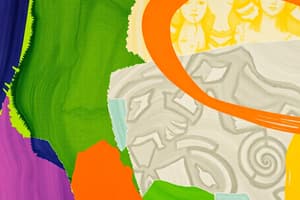Podcast
Questions and Answers
Which of the following is NOT a common ethnographic study method used to understand the Saora tribe?
Which of the following is NOT a common ethnographic study method used to understand the Saora tribe?
- Observation of daily activities and rituals
- Participant observation by immersing in the community
- Conducting surveys with multiple-choice questions (correct)
- Analyzing Saora texts, myths, and historical accounts
What is the primary purpose of observing the Saora people's daily activities and interactions?
What is the primary purpose of observing the Saora people's daily activities and interactions?
- To study their genetic makeup and ancestry
- To document their language and linguistic patterns
- To assess their economic status and livelihood strategies
- To gain insights into their values, beliefs, and behaviors (correct)
Why might a researcher choose to participate in the daily lives of the Saora community?
Why might a researcher choose to participate in the daily lives of the Saora community?
- To assess the community's suitability for tourism development
- To exploit the community's natural resources for personal gain
- To convert community members to their own religion
- To gain a deeper understanding of their culture from an insider's perspective (correct)
What type of information can researchers gain from analyzing Saora texts, myths, and historical accounts?
What type of information can researchers gain from analyzing Saora texts, myths, and historical accounts?
What is the primary focus of an ethnographic study of the Saora tribe?
What is the primary focus of an ethnographic study of the Saora tribe?
Which research method is mentioned in the text for gathering background information on the Saora tribe?
Which research method is mentioned in the text for gathering background information on the Saora tribe?
What is the primary language spoken by the Saora people?
What is the primary language spoken by the Saora people?
Which aspect of Saora culture is described as a unique economic activity?
Which aspect of Saora culture is described as a unique economic activity?
What is the role of the Buyya (or Buya) in the Saora tribe's social structure?
What is the role of the Buyya (or Buya) in the Saora tribe's social structure?
Which marriage practice is mentioned as being valued by the Saora people?
Which marriage practice is mentioned as being valued by the Saora people?
Study Notes
Ethnographic Study of the Saora Tribe in Ganjam District, Odisha
The ethnography of the Saora tribe in Ganjam District, Odisha, is a fascinating exploration of their unique culture, social structure, and daily life. This article presents an overview of the ethnographic study methods used to understand the Saora people, delves into their cultural practices, and examines the social structure within their communities.
Ethnographic Study Methods
Ethnography refers to the systematic study of human cultures and societies. To conduct an ethnographic study of the Saora tribe, researchers typically employ several key methods:
- Observation: By observing the Saora people's daily activities, rituals, and interactions, researchers can gain insights into their values, beliefs, and behaviors.
- Interviews: One-on-one interviews allow researchers to ask specific questions directly to individuals and gather personal narratives and perspectives.
- Participant Observation: Researchers may choose to become immersed in the Saora community by participating in their daily lives, thus gaining a deeper understanding of their culture from an insider's perspective.
- Document Analysis: Reading Saora texts, including myths, legends, and historical accounts, provides valuable context about their beliefs and worldview.
- Archival Research: Consulting existing records, maps, and histories can offer background information on the tribe's geographical location, demographic makeup, and socioeconomic status.
Combining these methods allows researchers to construct a holistic picture of the Saora people's culture and social structure.
Saora Tribe Culture
The Saora tribe is part of the larger Munda group of people native to eastern India. They predominantly inhabit regions in Odisha and number over 709,349 worldwide. Linguistically, the Saoras speak a Munda language known as Sora, which they share with other Munda groups like the Oraon, Kols, and Ho. Their religion is primarily Hindu, though many Saora people have converted to Christianity in recent decades.
Saora culture is steeped in animist beliefs and shamanic practices. They worship a variety of deities, including ancestral spirits, nature gods, and village guardians. Traditionally, the Saora economy relied heavily on shifting cultivation—a practice where farmers move between patches of land instead of staying put in one place. Additionally, men hunted wild animals, which were considered sacred offerings to the local deity.
One unique aspect of Saora society is their weekly markets or "shandies," which serve as important economic hubs, cultural exchange spaces, and points of contact with other tribes and Western culture.
Social Structure of Saora Tribe
The Saora tribe has a hierarchical social structure that includes different roles within each village. These positions are hereditary: the Gomango (or Gamong) acts as the secular head, while the Buyya (or Buya) serves as the religious leader. Other key figures in the community include the Mondal, Raito, and Barik, who hold various administrative and messenger duties.
Marriage among the Saora people is diverse, encompassing bride capture, elopement, and negotiations between families. The tribe values endogamy, which means marrying within one's own group or clan, although this practice appears to be less strict than it once was. Families can range from nuclear to joint or extended, depending on individual circumstances.
In summary, an ethnographic study of the Saora tribe in Ganjam District, Odisha would involve employing a combination of research methods to explore their unique cultural practices and social structure. By immersing themselves in the Saora community, researchers could gain valuable insights into the complexities of this fascinating tribe.
Studying That Suits You
Use AI to generate personalized quizzes and flashcards to suit your learning preferences.
Description
Explore the ethnography of the Saora tribe in Ganjam District, Odisha, including their unique culture, social structure, and daily life. Learn about the ethnographic study methods used to understand the Saora people, their cultural practices, and social hierarchy.




